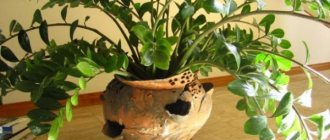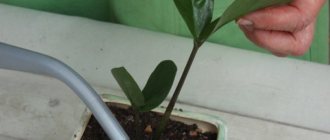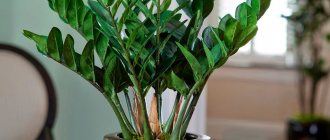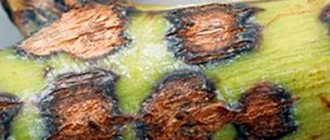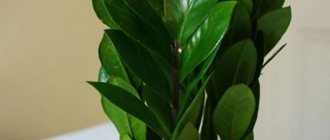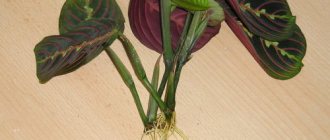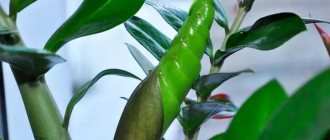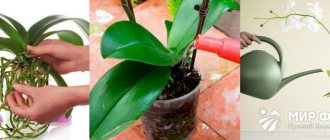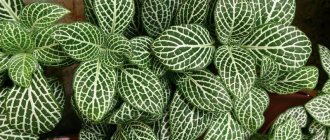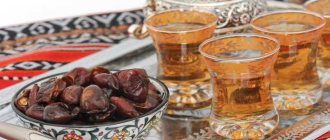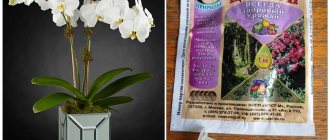More recently, Zamioculcas, also known as the dollar tree, has begun to appear in the homes of houseplant lovers. The interesting appearance, unpretentiousness and benefits that, according to popular belief, the plant can bring make it one of the most beloved house flowers.
The first descriptions of Zamioculcas can be found in 1828 thanks to Conrad Lodiges, a famous foreign lover of tropical crops. The flower was even named after him for some time, but later the original version was approved.
Content
- Yellowing of the lower segments of leaves Symptoms
- Cause
- How to water correctly
- Symptoms
- Symptoms
HerrWick/Flickr.com
The popularity of zamioculcas , or dollar tree, is growing and growing. And along with it, problems associated with improper care of this plant also grow. What could be happening, what are the reasons , and how to correct the situation? It is these moments that we will consider.
Jürgen Diermaier / Personal archive
Why do the leaves of the money tree turn yellow?
There can be many reasons why zamioculcas leaves turn yellow. Foliage turns yellow, as a rule, due to the natural life cycle of the crop or due to the actions of the grower. In any case, you should never rush to conclusions. First, it’s worth determining the nature of yellowing, analyzing care, and remembering that, like any other plants, zamioculcas also changes foliage from time to time.
First you need to determine the nature of yellowing
In a short period of time, yellow leaves will not destroy the crop. This is only the first signal indicating a problem, and not the last, so there is always time to solve a strange symptom, the main thing is not to delay it.
Yellowing of the lower leaf segments
Symptoms
Individual leaf blades (component parts) turn yellow and fall off, starting from the bottom of the complex leaf of the plant.
Cause
The most likely reason is regular waterlogging of the soil . It is worth reviewing the watering regime , otherwise the process may become irreversible and you will lose the entire plant. Zamioculcas is a succulent that stores water for future use in almost all its parts, so it does not need excess moisture .
Wendy Cutler / Flickr.com
How to water correctly
In winter, watering is very moderate , especially if the contents are cool (less than +15 ° C). In summer, watering needs to be increased slightly , but the soil in the pot should always dry out 2/3 of the volume between waterings.
- It is very important to select pots that match the size of the plant's root system and suitable soil that drains moisture well. And never leave water in the pan for zamioculcas!
Forest and Kim Starr / Flickr.com
Home care
You won't have any special troubles with this pet. But some points in care still have to be taken into account.
Location and lighting
Zamioculcas will feel equally good on a southern window sill, as well as on an eastern or western one. In addition, it does not have to be placed on a window; you can select any place in the room where sunlight reaches at least 6-8 hours a day. Moreover, due to its size, it is unlikely that it will be possible to place the pot on the windowsill. If there is insufficient lighting, the leaves will lose their bright color and begin to shrink.
But if you still choose a south window, try to shade it in the hottest summer and protect it from direct sunlight to avoid burns.
In winter, you can add additional light to the bush, and with the onset of spring, gradually accustom it to the sun. In summer, you can take your pet out onto the balcony or into the yard.
Temperature
The African guest is accustomed to warmth. In summer he will feel comfortable at +21-29°C, in winter you can lower the temperature to +15-18°C. The room where an overseas guest is kept must be regularly ventilated.
Watering
The dollar tree is not accustomed to water. It should be watered until the substrate is half dry. In winter and autumn, when it is cloudy outside, you need to do this even less often and under no circumstances overwater. It is best to wait until the soil is completely dry and only then water it. Stagnation of liquid in a flowerpot is detrimental to the patient.
Before watering, the water should be allowed to settle for 24 hours. The flower comes from arid Africa, so it accumulates moisture in the stems. So in this case it is better not to top up than to overfill.
Air humidity
The succulent does not require high humidity. He will be quite happy with the room atmosphere. There is no need to specially humidify the air. But in the summer, it is advisable to spray the leaves to clean them of dust. At the same time, make sure that droplets of water do not fall into the pot. It is best to cover the substrate with polyethylene before the procedure.
The soil
A substrate for cacti is suitable for zamioculcas. The soil must be neutral. If you want to assemble the mixture yourself, then you need to mix in equal proportions:
- leaf soil;
- turf;
- peat.
Before pouring the soil into the pot, you should lay out a layer of expanded clay and pour river sand on top of it.
Feeding and fertilizers
Twice a month you should feed your pet with fertilizers for succulents. Just reduce the dose indicated on the package by half. In winter, the plant does not need nutrients.
Transfer
Young specimens grow faster, so they need to increase their living conditions every year. In the future, this should be done every 2-3 years, and it will be enough to move 6-7-year-old veterans to a new pot once every 5 years.
It is advisable to choose a high capacity, since in a wide one the money tree will direct all efforts to the development of the root system, and the above-ground part will slow down growth. Drainage should occupy a quarter of the volume of the flowerpot. Be sure to have holes to drain excess liquid.
Transplantation is carried out in spring or summer. In this case, you need to handle the root system very carefully. The slightest damage threatens the death of the flower. It is even recommended to break the pot to keep the roots safe and sound. There is no need to shake off the old soil, just transfer the bush to a new place, adding fresh soil mixture.
It should be borne in mind that zamioculcas is poisonous, so you need to work with it with gloves, taking all necessary precautions.
Garter
To avoid large sheet plates from collapsing, they should be supported as they grow with a special ring on supports.
Falling leaves
Another reason for yellowing of leaves and their falling can be cold air or too sudden temperature changes in winter, especially if the plant is standing on the floor.
It happens that during the day the house is very warm (in sunny weather, for example), and at night the temperature drops sharply. excessive changes are harmful for any plant . It is better if the room is either consistently cool or consistently warm.
- Sudden changes in temperature or light levels can also cause suddenly rather than gradually .
Forest and Kim Starr / Flickr.com
Tips for growing Zamioculcas
The recommendations below will solve the problem of yellowing leaves and help the crop recover faster.
- When processing root sections, you can add a little root formation stimulator to activated carbon.
- If the leaves gradually turn yellow and then become colorless altogether, this means that the plant is not getting enough light or nutrition. You need to move it to another window, maybe this will help. But if it doesn’t help, you will need to fertilize.
- If the gardener is afraid to use mineral fertilizers, you can make fertilizer for zamioculcas from humus, eggshells or fresh herbs. Infusions of these products are nutritious and no less useful than minerals. You just need to use them in low concentration!
Zamioculcas is a beautiful crop. If you care for it properly, it will never bring any special problems, but will only attract good luck and financial well-being to the family. If the plant begins to turn yellow, you should not be upset in advance, you need to think about what the reasons might be, solve them, and then the culture will recover very quickly.
- Author: Maria Sukhorukikh
Rate this article:
- 5
- 4
- 3
- 2
- 1
(0 votes, average: 0 out of 5)
Share with your friends!
Softening tissue
Symptoms
Branches (compound leaves ) become soft at the base , leaf blades and thickened petioles rot .
Cause
The most common reason for this condition of the dollar tree is, again, a violation of the watering regime . Excessive watering, waterlogging of the soil and water standing in the pan are the main causes of the problem , especially if this happens indoors in winter at unfavorable temperatures (too cold or too warm).
soft black spots appear on the leaves (not to be confused with the natural “spotty” color of the petioles), then this also tells us about excessive watering.
marijana1 / Personal archive
Reproduction
It is not possible to find Zamioculcas seeds in Russia, so the “dollar tree” is propagated only by vegetative means, for which all healthy parts of the plant are used.
The first method is to divide an adult plant. The plant is removed from the pot, the rhizome is divided into parts, which, after drying, are planted in a separate flower pot.
The second method is cuttings. A stalk with 2–3 leaves is cut from the zamioculcas, dried, and the tip is treated with charcoal and root. The cuttings are planted in coarse sand or a mixture of sand and peat (recommended depth about 1 cm), the soil is watered with warm water. To maintain moisture, the pot with the cutting is covered with cellophane (plastic cup, jar, or glass). The pot with the cuttings is placed in a warm place with diffused lighting and sprayed regularly. The roots of the cutting will appear in a month and a half, after which the zamioculcas cutting must be transplanted into a small pot with loose soil (for example, into soil for cacti and succulents). Sand, perlite or vermiculite are added to regular soil for porosity.
The third method is propagation by a single leaf blade. The leaf, separated from the plant, is dried and planted in light sandy soil, deepened by 1/3. After watering, the pot with the seedling is covered with cellophane (plastic cup, jar or glass), and then regularly ventilated. Tuber roots take a long time to form, so new leaves will appear in about six months. For faster rooting, if desired, you can use “Kornevin”, “Heteroauxin”, “Zircon”.
Leaves turn pale and stretch out
Symptoms
Young shoots are too long, elongated (the internodes between the leaf blades increase significantly), pale , often underdeveloped and weak.
Maja Dumat / Flickr.com
Cause
Since Zamioculcas is a generally very patient and hardy plant, the reason for this condition can only be a combination of several factors .
Too indoor air in winter lack of minimally adequate lighting during the period of active growth, excess nitrogen fertilizers and excessive watering . The problem lies in the combination of several or all of these factors at once.
- As a rule, this happens in winter or early spring , when the plant should be kept cooler (+16-18 ºС), and watering should be more than moderate.
- If this happens during a period of active growth , then the reason may be a lack of nutrients or very poor lighting .
pxhere.com / Personal archive
Common processing errors
Errors when processing plants are not uncommon, however, they harm no less seriously than diseases, so before you start treating a flower, you need to take into account the negative experience of other gardeners.
The main mistakes when processing plants, measures for their elimination and prevention:
| Description | Remedies |
| Failure to comply with the concentration of substances (leads to burns of the flower) | Before processing plants, get measuring cups and pipettes. |
| Mixing two drugs | Before each treatment, clean all measuring containers and auxiliary equipment. |
| Neglecting the time between spraying | When treating a flower, create a special calendar in which to enter the treatment time, quantity and type of drug used. |
| Wrong choice of drug | Each disease is treated with a narrow range of drugs, so before spraying you need to study its instructions, as well as accurately identify the disease. |
| Using the same medications every year (due to which their effectiveness decreases) | Replace medications at least once a year; create a special schedule for using protective equipment to control. |
| Long-term storage of solutions | Store working fluids for no more than 24 hours after preparation; subsequently, their effectiveness decreases. |
Diseases and pests often affect zamioculcas, since a home pot is not the best place for the natural immunity of a flower to function. Zamioculcas needs regular care, examination and preventive measures.
The plant has become thinner
The leaf blades have become thin , and the previously fleshy leaf petioles have become very wrinkled .
How long have you been watering the plant? If its leaf “bottles” have also shriveled, then, for sure, you have managed to dry even zamioculcas. The plant survived on its succulent properties and most likely gradually depleted its reserves of moisture , set aside for a rainy day.
- Resume watering , only a little and gradually . Soon the plant will fully recover.
Krzysztof Ziarnek, Kenraiz / Personal archive
What to do to save the plant
Knowing why the leaves of zamioculcas turn yellow, you can determine a method for eliminating the problem.
- If watering is carried out incorrectly and the ground is too wet, it is necessary to remove the plant from the wet soil, remove excess soil that can be removed by hand, and then check the root system. If there is rot on the root, it is cut off and the sections are treated with a crushed tablet of activated carbon. After this, the crop is planted in new, dry soil.
If there is rot on the root, cut it off
- When a plant has suffered from an abundance of fertilizing, all that can be done is to replant it in new soil and just wait until it begins to recede. You should not apply new fertilizers until the plant has completely recovered and is growing again. Then, no earlier than 6 months later (if it is not winter), you can apply fertilizing.
Zamioculcas stopped growing
Zamioculcas is generally a slow-growing plant, and if it does not show signs of growth in winter , then this is normal and is no need to worry until spring
If this happens during the period of active growth (from spring to autumn), then the cause may be a lack of nutrition or a too cramped pot.
- In such a situation, the plant needs to be replanted , moved to a brighter place and, after a month or two, begin regular feeding . And Zamioculcas will definitely give you new shoots.
Mr.Rosewater / Personal archive
Why does Zamioculcas not produce new shoots?
The reason why zamioculcas leaves turn yellow, lose their rich green color or completely wither is often due to a lack of light. Unfortunately, flower growers forget about the change in illumination during the autumn-winter period.
The pot with zamioculcas located in the back of the room needs to be moved closer to the window; when this is not possible, the culture is provided with additional lighting.
The owner of an ornamental plant who complains that Zamioculcas does not produce new shoots should pay attention to the location of the pot and the quality of the soil in it. Although the plant cannot be called fast-growing, the slowdown in the formation of young foliage is often explained by a substrate poor in nutrients or the need to replant a green pet. In this case, the root system occupies the entire volume of the pot, leaving no room for soil. Because of this, the flower suffers, the leaves of the zamioculcas turn yellow, growth stops, and the existing greenery withers.
To correct the situation, a pot of the proper size is selected for the decorative crop, and the zamioculcas is transplanted or fertilized with a complex composition.
The main point of growing
Zamioculcas usually grows and develops without problems. This is one of the most unpretentious plants in the world. It is suitable for everyone , even the most inexperienced and novice flower growers. Zamioculcas should not be planted only by those gardeners who love to water their plants too much.
- The main reason for its poor health and death is precisely incorrect, excessive watering . regulates the amount of moisture for the time being , storing it in its leaves and tuberous rhizome, and then begins to “ signal .” If the plant is bad and it is dear to you, then it needs help .
Mokkie / Personal archive
Pests and ways to combat them
The dollar tree has an excellent protective covering on the stem and leaves. If it is violated due to improper care, the plant is attacked by pests that cause significant harm to the flower.
Signs of dangerous parasites and how to combat them:
- The scale insect is a small brown pest, 4 mm long, visible to the naked eye, and feeds on flower sap. When damaged, the plant becomes covered with dark spots in different places on the trunk and leaves. To get rid of it, a soap solution is used, which is used to wipe parts of the flower, then treated with chemicals, for example, Actellik, Aktara, Akarin, Antiklesch.
- Aphids are small black insects. As a result of damage by the pest, the leaves of Zamioculcas curl and turn yellow. Intavir, Actellik, Fitoverm are used for treatment.
- Mealybug - feeds on plant sap from leaves. Envelops them in sticky white cotton, which prevents the flow of oxygen. At an early stage of infection, the parasite is washed off with a soapy solution using a sponge. In case of severe infection, chemicals are used: Fitoverm, Intavir, Actellik and others.
- Thrips - parasite infestation manifests itself in the form of white spots on the leaves and twisted shoots. Karbofos and Intavir are used for treatment.
- Spider mites are small red (1 mm) spiders that settle on the back side of the leaf and envelop it with a white web. To get rid of them, use an alcohol solution, which is used to wipe the surface of the leaves. In hard-to-reach places, treatment is carried out using cotton swabs. Then the plant is sprayed with Aktara or Aktellik.
Zamioculcas is always ready to delight its owners with beauty if the conditions for its cultivation are met. Regular inspection of the flower for diseases and pests will help prevent infection and death of the plant.
Ambulance for Zamioculcas
At the first painful signs of waterlogging, stop watering the plant . Allow the soil to dry completely and the plant to recover. However, if you see that Zamioculcas is only getting worse , proceed to “ rescue measures .”
- Remove the plant from the pot.
- Rinse the root system with water. Inspect and feel the roots and tubers.
- Cut out all rotten areas with a sharp knife to healthy tissue and sprinkle the wounds with crushed charcoal (activated charcoal .
- Place the plant on paper and let it dry for several days.
- If you plan to plant zamioculcas in the same pot , wash it with a brush and soap and disinfect it .
- Get fresh succulent soil . Place a drainage layer of 2-4 cm at the bottom of the pot, depending on the height of the dish and the plant itself.
- Plant zamioculcas in fresh soil. Place it in the same way as it grew before, without deepening it .
- Place the pot in the brightest place in the house, protected from midday direct sunlight at first.
- After planting, do not water Zamioculcas for 3-4 days. Then start watering little by little , lightly moistening the top layer of soil. If signs of the disease no longer appear, start watering the plant a little more, but also very sparingly.
- Do not feed the transplanted plant for 1.5-2 months.
Andreas Hammerschmidt / Personal archive
If the rotting of the plant turns out to be too severe , you can try to save it by taking cuttings from the remaining healthy parts. For these purposes, a whole leaf, any fragment of it, or even a separate leaf blade is suitable Be patient - the process of propagating zamioculcas by cuttings is quite lengthy .
And do not forget that the plant is poisonous (like many representatives of the Araceae family), it is advisable to carry out all work with it wearing protective gloves .
Types and varieties
As mentioned above, there are several subspecies of Zamioculcas.
Zamioculcas zamiifolia
Otherwise called Loddies. The origin of the plant is South Africa. This representative of the flora is quite expensive, but despite this, it is very common and is in great demand among gardeners. The appearance of the plant is very unusual. It grows from a large tuber and has 4-6 pinnate leaflets with medium-sized leaves. Grows up to 1 meter in height.
It is the zamioculcas plant that is most often grown indoors.
Zamioculcas Bouvena
It grows in South Africa, mainly on the coast of Madagascar. This flower is often called “Women’s happiness.” This subspecies does not tolerate dry air. The flower has leathery emerald green leaves, blooms rarely and does not last long. Currently, it is classified as a different plant species, namely Boivin's Gonatopus, but many gardeners continue to classify it as Zamioculcas.
Zamioculcas lanceolata
So called because of the elongated leaves of an unusual lanceolate shape. It can reach a height of 1.5 m and above. In 2007, breeders bred a plant that is a complete copy of the ancestor, but in miniature: only 60 cm in height.
Zamioculcas Black
A plant with almost black leaves. Young shoots are light green, but as the bush grows, they begin to darken. The leaves are fleshy, attached to a common stem, pointed at the tips.
